Injections for arthritis
Arthritis is a lesion of one or more joints that become inflamed for many reasons. Arthritis can be a consequence of a systemic disease or occur as an independent disease.
This pathology is very widespread, and every year the number of cases is only increasing. Regardless of the cause of arthritis, the main symptom is always pain. It can be acute and torment a person for a long time. But it happens differently - aching and arching pain disappears as suddenly as it appeared.
Features of the course of arthritis are very diverse, and largely depend on its origin. That is why it is so difficult to make a correct diagnosis, because the cause can be an infection, trauma, an allergic reaction, autoimmune pathologies, metabolic diseases. There are also types of arthritis, the causes of which remain not fully understood. A prime example of this is rheumatoid arthritis.
Therapeutic injections
Arthritis therapy is always complex, and requires the patient to strictly comply with all medical recommendations. Injections for arthritis are prescribed only in the later stages or with a pronounced pain syndrome, when it is not possible to cope with inflammation in the joints with the help of tablets and ointments.
Arthritis injections can be subcutaneous, intramuscular, intraarticular and intravenous. According to the indications, intra-arterial, intra-pleural, intra-cardiac, intra-osseous, and spinal injections are used.
Medicines for introduction into various media are aqueous and oily. Suspensions, powders and tablets require prior dilution in saline or water. The most important condition for the injection procedure is absolute sterility.
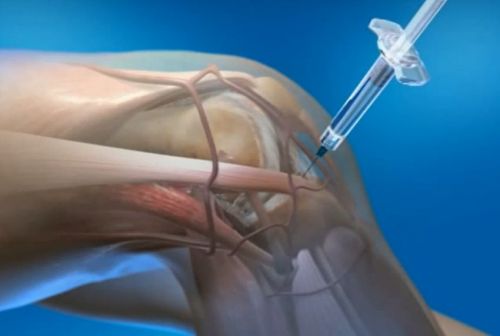
Joint injections may be accompanied by swelling and redness, to eliminate discomfort, you can apply ice or a cold compress to the injection site
The advantages of injection therapy are:
- speed of action - the effect occurs within a few seconds;
- the possibility of administering drugs to an unconscious patient - in emergency cases requiring emergency medical care;
- maximum bioavailability, which approaches 100%;
- the possibility of anesthesia of a specific area (local anesthesia), for example, when the drug is injected into the joint cavity;
- dosing accuracy and guaranteed hit of the medicine to the sore spot;
- a minimum of side effects from the gastrointestinal tract, which is very important for patients with concomitant diseases in terms of gastroenterology.
The high effectiveness of injections has been scientifically proven, but only the attending physician can prescribe them, and a medical officer of the appropriate qualification can carry out the procedure.
Who is assigned
The injection technique is used in cases of severe joint damage, and all manipulations are performed in the sterile conditions of a medical institution. Most often, injections are prescribed for rheumatoid arthritis of large joints - knee, hip and shoulder.
Indications for intraarticular administration of drugs are:
- osteoarthritis;
- gout;
- post-traumatic injuries;
- rheumatoid arthritis;
- synovitis;
- tendinitis;
- tunnel syndromes;
- coxarthrosis;
- gonarthrosis;
- severe pain and inflammation.
Contraindications for injection treatment:
- bone fractures with joint damage;
- type 1 diabetes mellitus;
- instability in the joint;
- hematological pathologies (blood clotting disorders);
- stable high blood pressure;
- problems with the gastrointestinal tract - gastric and duodenal ulcers in the acute stage;
- severe degree of encephalopathy;
- recurrent angina.
For the treatment of arthritis, corticosteroid and chondroprotective drugs, as well as products based on hyaluronic acid, are prescribed.
Powerful action of steroid hormones
With an intense inflammatory process and severe pain syndrome, doctors prescribe injections of corticosteroid drugs. These funds are an alternative to pills and ointments, which do not always help and not for everyone. Injections into the joints help with inflammation of the shell of the joint capsule and the presence of excess fluid in the joint cavity.
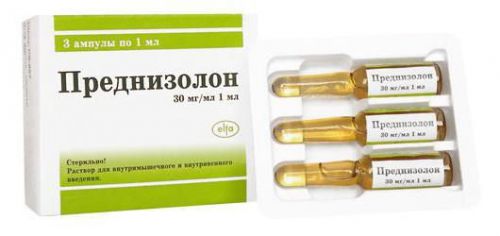
A highly active derivative of Hydrocortisone - Prednisolone - has a strong anti-inflammatory effect, its dosage is determined by the size of the joint
The drugs of choice from the group of corticosteroids are:
- Prednisolone, Methylprednisolone;
- Hydrocortisone;
- Celeston;
- Depot medrol (methylprednisolone acetate);
- Diprospan;
- Flosteron;
- Kenalog;
- Triamcinolol;
- Betamethasone.
To enhance the effect, the joint is pre-washed with sterile saline, after which a corticosteroid is injected with the same needle. To prevent dryness in the joint, it is possible to introduce 5 ml of Hemodez.
It is worth noting that the positive effect occurs almost immediately after the procedure: inflammation decreases, the pain subsides or even completely disappears. Injections with hormonal drugs are a kind of "ambulance" for joints when other means do not cope with their task.
In most cases, the effect of the injection lasts for a month, but in severe cases of the disease, the duration is reduced to several days. Then intra-articular infusions are repeated every 10 days - this is the minimum break between procedures, which is necessary to prevent the occurrence of side effects.
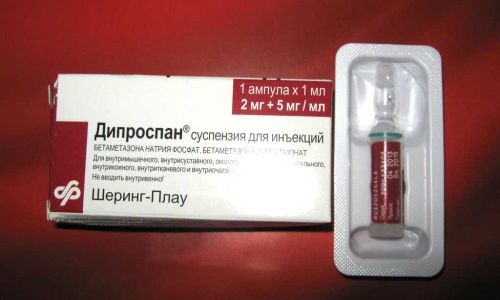
Diprospan has a dual mechanism of action - it stops the inflammatory process and provides a long-term remission.
There is also a limit on the number of injections in the same joint - there should not be more than 10, since repeated administration of corticosteroids can cause degenerative changes in the periarticular tissues. In other words, the harm will outweigh the benefit of the drugs. Therefore, a good effect after one procedure is the basis for stopping further infusions of corticosteroids.
Contraindications to injection treatment with hormonal agents are the following:
- infection of the joint or surrounding tissues;
- severe deformity of the joint;
- damage to the hip joints;
- lack of positive dynamics during treatment (corticosteroid injections are cancelled).
Which drugs a particular patient needs depends on many factors, including his state of health. Therefore, it is worth trusting the attending physician, who will draw up a treatment regimen based on the examination.
Chondroprotectors
Preparations from the group of chondroprotectors are especially effective in the early stages of polyarthritis. Their action is based on the improvement of metabolic processes in cartilage tissues, which become more resilient and elastic. In addition, the formation of articular lubrication, which is necessary for the normal operation of the joints, increases.
The main advantage of chondroprotectors is the cumulative effect. The active components of the preparations are embedded in the hyaline cartilage, thereby improving the quality of the synovial fluid. Due to the prolonged action of drugs of this group, the therapeutic course requires a certain time.
On average, the treatment course is four months, however, with intra-articular administration, the rate of inclusion of active elements increases many times over. According to experts, the best for the treatment of arthritis are combined preparations that contain not only glucosamine and chondroitin sulfate, but also anti-inflammatory components, vitamins and minerals. Delivery directly to the affected area of such a powerful complex helps to increase immunity and improve the overall health of the body.
For intraarticular administration, the following drugs are used:
- Hondrolon;
- Target-T;
- Elbon.

Alflutop has a natural composition, the basis of which is the bioextract of marine fish
Hyaluronic acid is a physiological substitute for intra-articular fluid
In advanced forms of arthritis, when dystrophic damage to the joints is combined with a violation of the production of synovial fluid, intra-articular injections are prescribed to replace it. Hyaluronic acid is a unique remedy, which is also called a “liquid prosthesis”. This substance prevents the friction of the bones among themselves and contributes to the return of the motor ability of the bone joints.
The effect of the use of hyaluron is higher, the earlier treatment is started. In the later stages of arthritis, the drug is not so effective, although it helps to improve the patient's well-being. For injections apply:
- Synocrom;
- Crespin gel;
- Ostenil;
- Euflex;
- Orthovisk;
- Gialgan;
- Synvisc;
- Suparts;
- Fermatron;
- Noltrex;
- Adgelon;
- Singial.
When it enters the joint, the lubricant acts almost instantly, evenly distributed over all surfaces and preventing friction of neighboring structures. Metabolic processes are activated, and the nutrition of cartilage tissue improves.
Hyaluronic acid is successfully used in the treatment of large joints, as well as in the complex therapy of articular pathologies of the foot and ankle. The main condition for its successful use is the preliminary relief of acute symptoms.
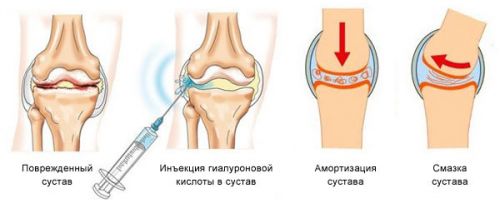
The therapeutic course includes one to five injections with a weekly interval between injections. At the same time, you should not wait for a deterioration in well-being and the appearance of pain, but undergo treatment systematically, according to the scheme drawn up by the doctor. Medicines for the treatment of joints are available in ampoules or in sterile syringes, which are used during the procedures.
It should be noted that preparations based on hyaluronic acid have a drawback - a rather high cost. However, it is fully justified by the long-term analgesic effect and good tolerance by patients.
With the help of injections with HA preparations, it is possible to postpone the timing of arthroplasty and help those who are contraindicated in surgical intervention - with diabetes mellitus, during the rehabilitation period after a heart attack and stroke, etc.
New generation drugs
The modern pharmaceutical industry is actively developing and offers more and more new and effective products. These include drugs for the basic therapy of rheumatoid arthritis - cytostatics and immunosuppressants. These funds are prescribed mainly in the early stages, when there is still time before the appearance of pronounced symptoms - the so-called "therapeutic window". It is recommended to use them even before the diagnosis is made.
Therapy with basic drugs helps prevent serious joint deformities, cardiovascular diseases and bone fractures in osteoporosis. The basis of the treatment of rheumatoid arthritis is immunosuppression, or suppression of one's own immunity. This allows you to achieve a significant improvement in the patient's condition and slow down the progress of pathological processes.
For treatment to be successful, therapy with basic drugs must be continuous, prolonged and differentiated.
A recognized leader in the basic treatment of RA, the cytostatic Methotrexate has become widely known as an antitumor drug. In oncological practice, cytostatics are used to reduce the rate of cell division, including malignant ones.
To slow down the growth of the tumor, patients are prescribed cytostatics in large doses, which often causes complications. That is why patients, like some doctors, are wary of cytotoxic drugs, considering them too toxic and fearing side effects.
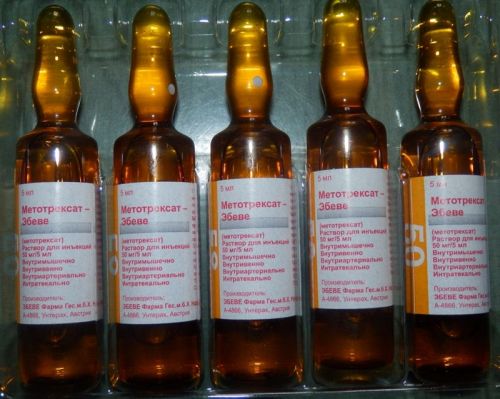
Methotrexate suppresses the signs of arthritis and slows down the pathological process. But the drug is very serious, so there can be no question of self-medication
However, in relation to the treatment of arthritis, the danger is clearly exaggerated, since much lower dosages are used in arthrology than in oncology. Doses of cytostatics in this case are 5, 10 and even 20 times lower! Due to the very low number of immunosuppressants entering the body, side effects are extremely rare. And the positive effect sometimes exceeds expectations, since positive dynamics is observed even in severe progressive forms of rheumatoid arthritis.
As for side effects, they occur in about 15% of cases and are limited to the fact that:
- a skin rash appears;
- there is a feeling of running goosebumps;
- perhaps a temporary disorder of the stool and urination.
It is worth noting that all side effects disappear immediately after the drug is discontinued. Methotrexate can be taken in the form of tablets, intravenous or intramuscular injections.
Intra-articular drugs such as Cyclophosphamide (cytostatic), gold salts, Kontrykal, Trasilol, Somatostatin and Dimexide can also be administered. The indication for the introduction of Cyclophosphamide is an increased content of rheumatoid factor and phagocytes in the synovial fluid.
Dimexide 20%, like Somatostatin (a hormone of the hypothalamus), helps relieve inflammation in the joint. All of these drugs are administered together with Hydrocortisone or Kenalog (half dose).
Possible Complications
Injections into the joint are made by a traumatologist exclusively in a hospital setting and under ultrasound control. Immediately after the procedure, redness and swelling may appear in the joint area. Pain and stiffness may also increase. Sometimes the symptoms go away after a few hours, but in some cases they last a little longer.

To avoid pain, before the injection, the doctor performs local anesthesia with an anesthetic spray.
Injection administration of drugs is characterized by a cumulative effect, the number of procedures depends on the stage of the disease. If the lesion is insignificant, the effect appears quickly enough. In advanced cases, it will take a long time to be treated, for several months or even years.
To enable the body to recover, therapy with the use of chondroprotectors and hyaluronic acid is carried out in courses, each of which consists of 10-20 injections.
Despite the fact that the treatment is always carried out under sterile conditions by an experienced specialist, complications cannot be ruled out. Any medical intervention is associated with risk, and with intra-articular injections it is possible:
- transient exacerbation of the disease in the first days after the injection;
- an allergic reaction to the components of the solutions (the drug is replaced);
- due to trauma to the periarticular tissues and frequent injections with glucocorticosteroids, the ligamentous apparatus weakens and the cartilage tissue is damaged. All this sometimes leads to "looseness" of the articulation;
- infectious, or septic, arthritis is one of the most dangerous complications that occurs as a result of infection. It is characterized by purulent inflammation and develops most often after the introduction of corticosteroids that reduce immunity.
Arthritis is a very serious disease that requires an integrated approach and careful attention to your health. And although injections into the joint are an unpleasant procedure, it can be used to achieve excellent results and a significant improvement in the quality of life of the patient.
